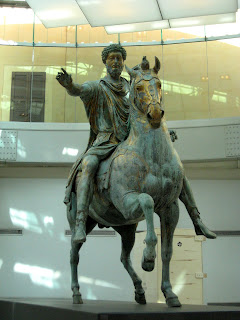 Today, we had planned to visit the ancient Romans—where they lived (the Palantine Hill), where they conducted their business (the Forum), and where they entertained the multitudes (the Colosseum), but it was so hot, even in the morning, that we skipped all that and had a leisurely tour of the Capitoline Museum. In front of it in a square designed by Michelangelo, we stopped to admire a modern copy of an ancient equestrian statue of the Roman Emperor, Marcus Aurelius.
Today, we had planned to visit the ancient Romans—where they lived (the Palantine Hill), where they conducted their business (the Forum), and where they entertained the multitudes (the Colosseum), but it was so hot, even in the morning, that we skipped all that and had a leisurely tour of the Capitoline Museum. In front of it in a square designed by Michelangelo, we stopped to admire a modern copy of an ancient equestrian statue of the Roman Emperor, Marcus Aurelius.
The original of this statue, which may be the only large bronze one ever to survive from ancient times, is housed in the Museum, where it is being painstakingly restored. The Emperor, who may be the closest ever to embody Plato's ideal of the philosopher king, sits bareback on a horse, his arm held out in a gesture of mercy and inclusion—an ancient version of an invitation to come into the “big tent” that we hear about so much about during our current elections. This statue, especially the mostly-restored original, is striking, and has been the model for countless others over the ages.
The Capitaline Museum offers a splendid view of the Forum, which is probably as close as we'll get to actually visiting it—or the Colosseum, for that matter. The heat and the lingering jet lag are taking a toll.

In the museum, we saw several sculptures, one of the most famous being the so-called Capitoline Venus, one of the best preserved ever from ancient Rome. It was dug up in 1670s, and thought to be a Roman copy of a lost 3rd- or 2nd-century BCE statue by the Greek sculptor, Praxiteles. It is one of the most copied statues in the world, and even spent three months of last year in the rotunda of the US Capitol, something that must have horrified Bush's Attorney General John Ashcroft.
The museum also has two Caravaggio paintings,
In his painting of Saint John, Caravaggio chose not to portray a saint-like man, but rather a real-life kid growing up in the wilderness. The effect on a contemporary viewer, aside from the shock of seeing a somewhat provocative nude, would be to say, “Look! Saints were real people, just like you and me.” The model was a boy named Cecco, Caravaggio's servant and possibly his pupil or even his lover, the same one who posed for “Amor Vincit,” which Bob, Karin and I saw last year in Berlin. Note how Caravaggio uses dark backgrounds and light to thrust the subjects of his paintings off the canvas at you.

After the museum, we returned to our own neck of the Roman woods for lunch and some much-needed down time. We thought about trying to get into St. Peter's at the end of the day, but the humid, 86 degree temperature made us decide to dine locally.

